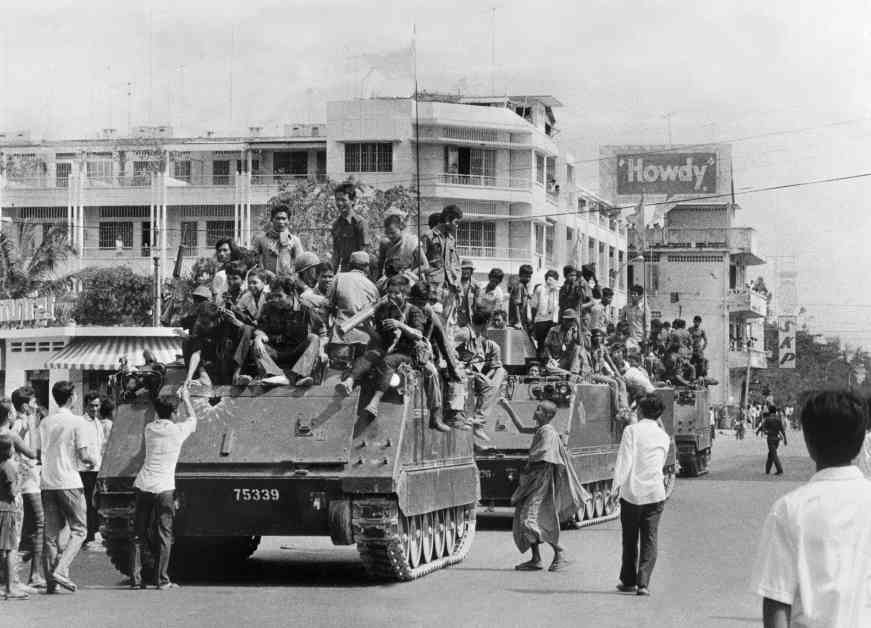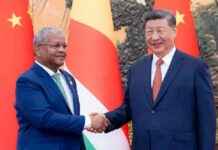Navigating the Complex Southeast Asia-China-US Relationship
“One lesson that I’ve learned after studying geopolitics for fifty years is that a benevolent great power is an oxymoron,” former Singaporean diplomat Kishore Mahbubani said at Asia Society, New York in March. “There is no such thing as a benevolent great power: All great powers, without exception, will pursue their own interests.”
Mahbubani, who served two terms as Singapore’s representative to the U.N., is one of many prominent Southeast Asians increasingly frustrated by external pressure on their countries to “choose” between aligning themselves with the U.S. or with China. Over the past 10 years, the U.S. has framed its vision for the region as the democratic, human rights-focused alternative to Xi Jinping’s world order, but many Southeast Asians doubt America’s commitment to upholding ASEAN interests alongside their own.
“For Southeast Asian countries, they cannot square the U.S.’ fixation with democracy, human rights and values, and the perceived inconsistencies in the U.S.’ actual policies and practices when realpolitik considerations kick in,” says Lee Sue-Anne, Senior Fellow at the ISEAS-Yusof Ishak Institute, a Singapore-based think tank. “Southeast Asians pointing out ‘whataboutisms’ and hypocrisy in U.S. foreign policy behavior has been a constant feature of anti-U.S. sentiment in the region.”
Lee and Mahbubani’s skepticism is warranted, and it is rooted in the history of American involvement in Southeast Asia.
The Evolving Landscape of Southeast Asia’s Geopolitical Relationships
As tensions between the U.S. and China escalate, President Joe Biden’s administration has emphasized its commitment to prioritizing relations with ASEAN member states. The region is not only a potential sphere of political influence but also home to some economically important partners: Southeast Asia’s aggregate GDP accounts for more than 7 percent of global GDP and collectively represents the fifth-largest economy in the world. On top of that, Southeast Asia is home to sea lanes that carry more than 40 percent of the world’s annual goods trade.
When assessing U.S. and Chinese influence in the region, political scientists and commentators often ask the question: “Who is winning in Southeast Asia?” A 2024 assessment of Southeast Asian attitudes, conducted by the ISEAS-Yusof Ishak Institute, surveyed 1,994 policymakers, journalists, businesspeople, and analysts. The results indicated that ASEAN states would prefer China over the U.S., if forced to align with either rival, by a margin of 50.5 percent to 49.5 percent. While the margin is small, the findings point to a reversal of trends seen in four previous surveys. As recently as last year, 61.1 percent preferred the possibility of alignment with the U.S., while 38.9 percent said they would align with China.
The Stimson Center attributes some of China’s appeal in the region to Xi’s generally relaxed approach to other countries’ domestic affairs. While the U.S. often proposes political preconditions for aid, China has distributed loans and poured aid into Southeast Asia—all while claiming that these investments come with few conditions aside from requiring recipient countries to adhere to the one-China principle.
ASEAN states are experienced in the practice of “hedging” and shifting alignments when necessary, but several countries have expressed a fear of being treated as proxies should a great power conflict break out between the U.S. and China. At the 2024 Shangri-La Dialogue in Singapore, Indonesian President-elect Prabowo Subianto reiterated Indonesia’s intention of not aligning with either the U.S. or China, mirroring current President Joko Widodo’s previous vow to not let Southeast Asia become the front line of a new Cold War.
Challenges and Concerns in Southeast Asia’s Geopolitical Landscape
These concerns have escalated amidst rising U.S.-China tensions and the 2024 U.S. presidential race. “A second Trump administration could raise tensions between Washington and Beijing to the point where even Southeast Asian governments, long skilled at the balancing game, may find it difficult to avoid taking sides,” says Joshua Kurlantzick, senior fellow for Southeast Asia at the Council on Foreign Relations.
Trump’s comment that, if re-elected, he would encourage Russia to do “whatever the hell they want” to NATO members has not sat well with the Philippines, one of Washington’s few allies in the region. Under President Ferdinand Marcos Jr.’s leadership, the country has taken strategic bets in allowing U.S. access to military bases in the archipelago and encouraging the wrath of China. Ramon Beleno III, a political science professor at Ateneo de Davao University in Davao City, told the South China Morning Post that he doubts Trump would protect the Philippines should conflict break out in the South China Sea: “He is very protective of U.S. interests. So, in choosing between protecting the Philippines and US interest, I don’t think he will [prioritize] the interests of Manila.”
The Complex History of American Involvement in Southeast Asia
With rising U.S.-China tensions and American leadership in flux, questions about the U.S.’s commitment to actually upholding the interests of ASEAN states, and not just treating them like proxies, are on the minds of many across the region, say Stanford-based human rights scholars David Cohen and Alexandra Koch. “From their standpoint, the U.S. track record is not good, and it will take more than a flurry of high-level visits to and from the region to provide the needed assurances.”
The plight of Southeast Asian states caught in the middle of great power competition is nothing new. This “track record” referenced by Cohen and Koch is rooted in the history of the U.S.’ Cold War strategy in Southeast Asia, throughout which the U.S. prioritized great power competition over human rights and the interests of the Cambodian people.
Today, competition with China drives many of the strategic decisions that Washington makes in the region, but after the 1975 fall of Saigon, a determination to befriend the Chinese Communist Party put human rights on the backburner of America’s approach to Indochina. After the American withdrawal, newly unified Vietnam’s burgeoning relationship with the Soviet Union emerged as a great threat to Richard Nixon’s containment strategy. A decade earlier, relations between the Soviet Union and the People’s Republic of China (PRC) had begun deteriorating due to differences in ideology, border and economic disputes, and personality clashes between the two countries’ leaders. Understanding that relations with the PRC might give the U.S. leverage over the Soviet Union in Asia, in February of 1972 Nixon visited Beijing and met with Mao Zedong to establish diplomatic relations between the two countries.
The Impact of Historical Events on Present-Day Geopolitics
During Nixon and Mao’s initial meeting, the two leaders reflected on their mutual interest in limiting Soviet influence, setting the groundwork for future conversations about rapprochement. While leadership changes slowed the process of establishing relations (Nixon resigned in 1974, and Mao’s health rapidly declined), President Gerald Ford and Secretary of State Henry Kissinger reinvigorated the undertaking in 1975 when they visited Beijing.
Around this time, reports began emerging from Cambodia that, upon seizing the Cambodian capital Phnom Penh in April of 1975, Pol Pot and the Khmer Rouge were attempting to return Cambodia to an agrarian past, purging society of educated, urban residents cast as corrupted by the West, in what would emerge as a genocide responsible for the deaths of some two million people. This, the Khmer Rouge believed, would allow Cambodia to develop swiftly and protect itself against Vietnamese invasions, as had happened throughout the 19th century. This staunch anti-Vietnamese agenda aligned with the PRC’s distaste for its Soviet-aligned neighbor to the south, and Mao quickly and publicly embraced Democratic Kampuchea—what Cambodia’s new communist regime called their country.
In August 1975, during a conversation with Huang Chen, chairman of the Liason Office of the PRC in the United States, Kissinger asked for China’s assessment of the Khmer Rouge’s seizure of Phnom Penh. Chen responded: “The situation in Cambodia is good,” clearly signaling that the PRC supported the anti-Soviet, anti-Vietnamese regime. In a December meeting with the Thai foreign minister, Kissinger said that the Ford administration would back China’s support of the Khmer Rouge: “You should also tell the Cambodians that we will be friends with them. They are murderous thugs, but we won’t let that stand in our way. We are prepared to improve relations with them.”
Outlets like The New York Review of Books, Reader’s Digest, and Le Monde delivered accounts of the millions killed under Pol Pot’s watch, building pressure on the Ford and Carter administrations to intervene. But they declined to do so. It was only after a May 1977 congressional hearing on human rights in Cambodia and pressure from abroad that Jimmy Carter, a self-described champion of international human rights, issued a formal denunciation of the Khmer Rouge, calling it the “worst violator of human rights in the world today.”
After Carter’s statement, the PRC, with whom the U.S. was still in the process of normalizing relations, expressed deep concern over the condemnation. During a visit to Beijing, PRC Foreign Minister Huang Hua told Zbigniew Brzezinski, Assistant to the President for National Security Affairs, that the Chinese “were surprised to see that the U.S. was creating out of thin air and making a big issue of human rights in Cambodia.” Likewise, CCP Chairman Hua Guofeng told Brzezinski: “[Carter’s statement] is quite different from the views of the Chinese side, and we feel that his statement was helping the Soviet Union.”
The Ongoing Debate on Human Rights and Geopolitical Strategy
In order to protect the process of rapprochement with the PRC, the Carter administration refused to issue any other public statements about the Cambodian Genocide or critique China’s support for the regime. Carter and Kissinger then vocally condemned the Vietnamese when they invaded and overthrew Pol Pot in January 1979. During a press conference in October, Carter compared the Vietnamese occupation of Cambodia to the Holocaust, calling it a tragedy that might soon reach “genocidal proportions.” Carter did not reference the between 1.5 and 3 million Cambodians who had already died during the 1975-1979 reign of the Khmer Rouge. In September 1979, the UN took up the question of whether Cambodia’s seat should be transferred from the Khmer Rouge to the Vietnamese-backed People’s Republic of Kampuchea. China and the U.S. voted together for the Khmer Rouge to maintain its seat in the international body.
American involvement in Vietnam has been the subject of criticism in the U.S. and around the world since the 1960s, but U.S. policy surrounding the Cambodian Genocide is at least as great a stain on the legacy of American engagement in Southeast Asia. Today, American claims to moral authority are undermined by the way in which the Nixon, Ford, and Carter administrations reacted to the rise, reign, and fall of the Khmer Rouge. Still, the U.S. uses human rights language to justify its criticism of China. U.S. Ambassador to China Nicholas Burns recently remarked that the U.S. and China are locked into a “long-term strategic rivalry” in which “we have completely different and opposite views about human freedom and human liberty.”
The Present-Day Repercussions of Historical Choices
While America has moved from befriending China to challenging it, U.S. commitment to upholding human rights in the region continues to be cast aside in favor of geopolitical leverage. As the current administration has continued to use human rights rhetoric to frame its Southeast Asia policy, it has strengthened ties with leaders who have questionable human rights records of their own. Relations between the U.S. and Filipino President Ferdinand “Bongbong” Marcos Jr. have blossomed, despite the continued persecution of journalists and civil society activists. Human Rights Watch has called on the U.S. government to more explicitly link future economic and security ties to demonstrable progress on human rights in the Philippines.
In an attempt to strengthen relations with Indonesia, the Biden administration has sought to strengthen ties with president-elect Prabowo Subianto, who was once sanctioned by the U.S. for human rights abuses. Moreover, America’s involvement in the war in Gaza hasn’t helped its reputation of prioritizing human rights above geopolitical strategy. Analysts believe that the war has contributed to a downward trend in trust of America among Muslim-majority countries like Indonesia, Malaysia, and Brunei.
If history provides a guide to the future, upholding human rights will continue to be sidelined in the U.S.’ Southeast Asia policy, and priority will be given to relationships and policies that benefit the U.S. as it seeks to build leverage over China. Given the history of America’s involvement in the region—especially in the case of Cambodia—Southeast Asians are understandably skeptical of American promises to champion human rights and protect their interests.
The Role of Geopolitical Rhetoric in Southeast Asia’s Relations
Chinese state-backed media outlets that distribute throughout Southeast Asia, like China Daily and The Global Times, have jumped on this point of contention, publishing articles accusing the U.S. of what they call “boundless” “hypocrisy on human rights.” Regional publications like The ASEAN Post have also published pieces that use this argument to question America’s claims that they can be a trusted partner in the region. As long as the U.S. continues to rely on human rights rhetoric framing itself as a competitor to China in the region, Beijing and its allies will continue to loudly make this argument, directing eyes on America’s complicated history in the region and its support of the Israeli offensive in Gaza.
While Southeast Asian states may not want to “choose” between these two great powers outright, they will inevitably continue to hedge their bets when it comes to engaging with both the U.S. and China on economic, security, and diplomatic matters. If the U.S. can’t use rhetoric to convince Southeast Asians that it will uphold their interests and human rights, it needs to identify other ways to show ASEAN’s leaders and constituents that their security and well-being will be prioritized by the U.S. even as tensions with China grow. It is not just the commitment of military assets that will persuade ASEAN to hedge towards the U.S., but rather their ability to trust American promises and commitments—a relationship that needs to be heavily invested in given the history of U.S. intervention in Asia during the Cold War. Southeast Asians have made it clear that they don’t want to be treated as proxies ever again, and it is up to the U.S. to find new ways to showcase their commitment to upholding the interests of ASEAN states without relying on empty human rights rhetoric as they have in the past.









![Indie music fans gather at l’Antipode for [Face B] Kool Things soirée on Saturday night news-15112024-105933](https://shanghainewstv.com/wp-content/uploads/2024/11/news-15112024-105933-218x150.jpg)







